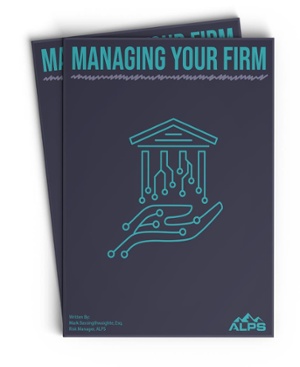Solo Attorneys: Don't Wait to Figure Out Your Succession Plan
The two most common excuses I’ve heard over the years for not having a succession plan in place are these. It’s either “my plan is to die at my...
We've crafted solutions tailored to your firm
The world of insurance for law firms can be confusing, and difficult to navigate. We've created this glossary because these common insurance terms should be easy to understand.
5 min read
 Mark Bassingthwaighte, Risk Manager
:
Mar 1, 2023 8:30:00 AM
Mark Bassingthwaighte, Risk Manager
:
Mar 1, 2023 8:30:00 AM

Over the years, I have found that the use of closure letters varies greatly, not only between firms, but even between attorneys practicing at the same firm. The excuses I often hear include statements like “we do a lot of flat fee in-and-out work here, so the effort just isn’t worth it,” “I’m not about to say goodbye get out of here, particularly to any of my good clients,” or “these matters never really close.” Honestly, I don’t buy into any of these excuses. Here’s why.
The purpose of a closure letter is to confirm that a client’s matter has been wrapped up, which means your involvement in that matter is now over. Viewed in that light, I do understand why some lawyers choose to see these letters as more of a goodbye, get out of here statement and thus don’t want to use them; but consider this. Closure letters can be a powerful marketing tool when placed in a different light. Regardless of whether a client is an in-and-out flat fee client or a long-term repeat client, every client has honored you by placing their current legal matter into your competent hands. Acknowledge that and say thanks! A simple thank you note that includes something like the following can do wonders in terms of repeat work and referrals.
This concludes our representation of you in this matter. We hope you found the quality of our work to be exemplary and we look forward to working with you in the future if and when the need ever arises. Thank you for allowing us to be of service. It was our pleasure.
If any given client has other matters still active, modify your letter accordingly. Instead of saying “we look forward to working with you in the future,” a statement along the lines of “we’ll be in touch next week in regard to your contract dispute” might be called for.
Beyond the value of saying thank you, several other significant benefits come with letters of closure. For example, consider using this letter to cut off unintended reliances. As attorneys, we often view flat fee in-and-out work as just that. Clients, however, may see it differently. They may feel like they have finally found their family or business attorney. If you don’t wish to have such clients mistakenly believe you will look out for their interests going forward, send a thank you letter.
Consider the simple will. If you have no intention of taking on the responsibility of informing everyone you’ve written a will for that the law has changed, cut off the possibility of that kind of unintended reliance. A statement inserted into a thank you letter along the lines of “Here are your wills, they should be reviewed every 3 to 5 years because laws do change” can help solve that problem in a non-dismissive way. The same would hold true for small business formations, particularly if you’ve decided to hold the corporate books for clients in the hopes that this will bring about additional work in the future. You don’t get something for nothing when it comes to holding on to the corporate books of your clients because some will interpret your doing so as meaning they can rely on you to continue to look out for their interests when that’s not what you intended.
 Get practical advice in the 5 most important areas of running a successful business right now with the free ALPS Guide to Managing Your Law Firm.
Get practical advice in the 5 most important areas of running a successful business right now with the free ALPS Guide to Managing Your Law Firm.A closure letter is also the perfect place to document final instructions to your clients. Even after you’ve completed your work, there may be times where a task or two remains for a client to complete. What might happen if a client fails to do that task (or does it incorrectly)? I believe attorneys usually do a pretty decent job of informing their clients about any remaining tasks a client must take care of. Unfortunately, attorneys don’t always document those instructions. Should the worst ever happen and your client’s memory of what was said substantially differs from yours, you’ve got a problem. In the malpractice arena, attorneys often don’t fare well in word-against-word disputes. This is why tax attorneys regularly write final instructions as to where to sign, where to send, what amount to pay, and by what date these steps must be taken in some type of closure letter. After all, they don’t want to pay the interest and penalties after a client, who has just missed a tax deadline, says “Why didn’t you tell me there’d be consequences if I missed that deadline?”
Two of the more significant benefits of a letter of closure concern conflicts of interest and the doctrine of continuous representation. In terms of conflicts, an interesting question that arises from time to time is when does a current client become a past client for conflict resolution purposes? The temptation is to rationalize that the passage of time coupled with a bright line gets you there. After all, doesn’t the fact that the deed was delivered four months ago, the settlement proceeds were disbursed last year, the judge signed the final order three years ago, or the contract was signed over five years ago mean that these various matters were concluded, and all of these clients are now past clients?
Our conflict rules don’t speak of bright lines or the passage of time as being determinative. Keep it simple. For conflict resolution purposes, once someone becomes a current client, they are always a current client unless and until you clearly document otherwise. This is typically done in a closure letter that clearly states something like “this concludes our representation of you in this matter.” In fact, this is the reason why conflict-savvy firms keep all letters of closure even after destroying the related file years after closing it. The closure letter is part of the conflict database because it documents who is a current client and who is a past client.
The doctrine of continuous representation and its tolling of the statute of limitations in malpractice cases can also be a problem. Losses have been paid on claims where the work was done 20, 30, and even 40 years ago. Here is an example of how this can happen.
A firm represented a client for years. The work always focused on oil and gas leases and by the time a problem arose, the number of leases the firm had been involved with was several dozen. Unfortunately, closure letters were never sent because they were viewed as offensive. The attorneys always feared they would be received as goodbye letters. A serious problem eventually arose with one of the older matters and the client ended up suing. The attorneys wanted to argue that the subject file was closed years ago; but of course, there was no documentation of that. Due to the continuous representation coupled with the failure to formally close any of this long-term client’s past files, an argument was successfully made that the running of the statute of limitations date had been tolled. If the firm had simply taken the time to send a thank you letter documenting that the work on each specific lease had been completed and the file was being closed, the outcome could have been quite different based upon an argument that the closure letter started the SOL clock running and the window of opportunity to file suit had long since passed.
Finally, sometimes I’ll hear that the time it takes to write closure letters simply isn’t justified from a business perspective. Yes, there may be times when a more formal letter is called for but understand that it’s fine to write to your audience. With some clients, a simple “thanks for stopping by” email may suffice. This task can also be made much more efficient if you develop a few templates for various practice areas. It’s going to be much easier to customize a basic standard letter than create something new each and every time. Just make sure that every attorney takes a minute or two to personalize the final letter whenever a standard template is used.
Since 1998, Mark Bassingthwaighte, Esq. has been a Risk Manager with ALPS, an attorney’s professional liability insurance carrier. In his tenure with the company, Mr. Bassingthwaighte has conducted over 1200 law firm risk management assessment visits, presented over 600 continuing legal education seminars throughout the United States, and written extensively on risk management, ethics, and technology. Mr. Bassingthwaighte is a member of the State Bar of Montana as well as the American Bar Association where he currently sits on the ABA Center for Professional Responsibility’s Conference Planning Committee. He received his J.D. from Drake University Law School.

The two most common excuses I’ve heard over the years for not having a succession plan in place are these. It’s either “my plan is to die at my...
We’ve all had difficult clients. In the best of times, they can be a challenge but in the times we’re living in right now they can be even more...

2 min read
Sometimes things change as matters progress, like the legal needs of the client, your ability to continue to provide competent representation, the...